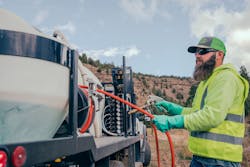Decades of results stemming from long-standing environmental research studies show that a variety of herbicide applications can be used to effectively manage incompatible vegetation throughout utility right-of-way (ROW) corridors. These applications can protect more than the integrity of utility infrastructure; they can significantly benefit environmental sustainability as well.
These optimum results can only be achieved when the right herbicides are properly applied by licensed applicators. Failing to do so can lead to the inadvertent control of off-target vegetation. Understanding the factors that generate these adverse effects, and knowing how to minimize their impact, is the key to success for programs that rely on herbicide applications to control incompatible trees, brush species or invasive weeds throughout the land they manage.
Herbicide Volatility
When a spray solution lands on a target plant, changes to a vapor and moves off-site, the result is known as volatility. Aside from herbicide application errors, herbicide volatility is a primary cause of off-target damage. While the movement of herbicides to off-targeted locations can be prompted by wind, the greatest potential for volatility occurs when herbicides are applied to impermeable surfaces and/or in areas where temperatures are high and humidity is low.
It’s important to note that the potential for volatility varies from one herbicide product to the next. As a characteristic of a herbicide’s formulation and/or active ingredient(s), the potential for volatility can be significantly lower — if not nonexistent — for certain herbicide products. For instance, TerraVue® herbicide from Corteva Agriscience features a low vapor pressure and absorbs rapidly into the foliage of targeted vegetation. This makes it extremely unlikely that TerraVue herbicide will move from an application site as a vapor, categorizing the product as essentially nonvolatile.
All vegetation managers are encouraged to abide by the following recommendations to minimize off-target control caused by herbicide volatility:
1. Check product labels to identify potentially volatile formulations.
2. Avoid applying herbicides in conditions where temperatures are high and humidity is low, or if there is a temperature inversion.
3. Try to not spray rocks, pavement or other liquid-resistant surfaces.
Spray Drift
When small or fine droplets of an applied herbicide move to nontarget vegetation without ever landing on the target site, the result is known as spray drift. Compared with herbicide volatility, spray drift is a far more common cause of off-target damage to desirable vegetation.
Similar to volatility, the potential for spray drift is greatly influenced by weather conditions, including wind, temperature and humidity. As large droplet sizes are less susceptible to unfavorable application conditions, the use of proper treatment techniques and associated equipment is essential to vegetation management programs working to minimize the negative effects of spray drift.
Wind, temperature and humidity can all impact the potential for spray drift when applying herbicides throughout utility rights-of-way.
Exercising good judgment and abiding by the following practices can ensure proper herbicide application and minimize potential risks to workers and environments adjacent to each application site:
1. Use proper nozzles that apply coarse, large and uniform droplets (>400 µm) and keep nozzle heights as low as possible when spraying.
2. Avoid spraying when sensitive plants adjacent to the application site are downwind.
3. Refrain from rapidly waving spray wands or guns back and forth during application.
4. Do not treat taller vegetation that’s upwind when sensitive crops or water are near the application site.
5. Consider using constant-flow valves, or other internal or external pressure regulators, and avoid high-pressure applications.
6. Use drift-control additives to dramatically reduce drift potential.
7. Always follow herbicide label directions.
For more information on application best practices and herbicide products used to optimize results for utility vegetation management programs throughout the United States, visit Utility.VegetationMgmt.com.
™ ® Trademarks of Corteva Agriscience and its affiliated companies. Under normal field conditions, TerraVue® is nonvolatile. TerraVue has no grazing or haying restrictions for any class of livestock, including lactating dairy cows, horses (including lactating mares) and meat animals prior to slaughter. Label precautions apply to forage treated with TerraVue and to manure and urine from animals that have consumed treated forage. TerraVue is not registered for sale or use in all states. Contact your state pesticide regulatory agency to determine if a product is registered for sale or use in your state. Always read and follow label directions. © 2022 Corteva.
Sponsored By:


